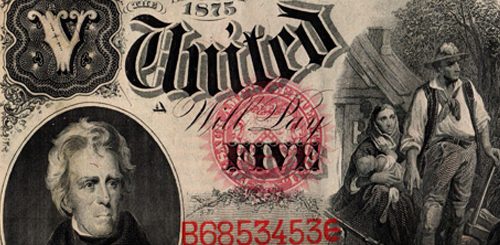Currency Spotlight: Series of 1875 $5 Woodchopper

The 1875 Series $5 Woodchopper note is distinctive for its red seal along with the Allison & Wyman signature. Some of these notes are available in Choice Uncirculated condition, and are prized by collectors since they are undervalued compared to many other notes produced around the same time period.
After the Civil War commenced the American government begin issuing bills primarily for the purpose of general circulation. The Union was no longer paying its soldiers in coinage, but still required a method for financing the conflict and engaging in trade. However, the citizens were nervous and demanded currency that had the backing of the government, leading to the creation of these notes.
Overview of The Series 1875 $5 Woodchopper
This bill features a white and off white texture, along with a seal and margins which are outstanding. A visible plate with the number 23 can be seen near the top center. These notes were also referred to as Greenbacks and were a form of currency distributed between 1862 and 1971, and were considered legal tender. The name Greenback was given due to the fact that the back side of the bill is almost completely green. However, these notes are “fiat” which means unlike other early bills they did not have the backing of either American Treasury Bonds, silver or gold.
This particular bill is the second of the Woodchopper series, and is associated with the 1907, 1880, 1878 and 1869 variants. The signature combinations might also differ from note to note. While some may be signed with “Allison & (and) Wyman, others might have a signature which says Allison & (and) New. Most of these notes display a portrait of American President Andrew Jackson but are sometimes confused with the national $5 bank note.
Seal Color And Collection Value
The Woodchopper is an interesting bill, because although collectors won’t encounter it often, when they do it still doesn’t receive much recognition. This however has not stopped the note from appreciating greatly in value. All display a seal which is red in color, but the “1875 Series B” is rarer than standard issues, and will command higher prices as a consequence. The rarest of all is the “Series A Woodchopper,” particularly in superior grades. The exact price for these notes will vary, but will almost always be in the four figures.
The inscription shows that these bills were printed and engraved at the Bureau for Engraving and Printing, under the U.S. Treasury and had a legal tender of five dollars. They are sometimes referred to by collectors and historians as being “large size” since they were considerably larger than the U.S. currency used in modern times, and aside from the Woodchopper, there were also certificates which were backed by silver and gold. Notes like the Woodchopper were considered legal tender however as they had the authorization of Congress, and would later be produced by the Federal Reserve after 1913. The Woodchopper and other early notes are prized for their beauty and stunning vignettes, and are considered works of art.


